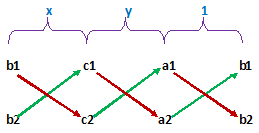CLASS-9
METHOD OF CROSS MULTIPLICATIONS - SIMULTANEOUS LINEAR EQUATIONS
Method of Cross Multiplication (Simultaneous Linear Equations) –
Theorem – consider the system of linear equations
a₁ b₁
a₁x + b₁y + c₁ = 0, a₂x + b₂y + c₂ = 0, where -------- ≠ --------
a₂ b₂
The above system has a unique solution, given by
(b₁c₂ - b₂c₁) (c₁a₂ - c₂a₁)
x = ---------------, and y = ----------------
(a₁b₂ - a₂b₁) (a₁b₂ - a₂b₁)
PROOF.) The given equations are –
a₁x + b₁y + c₁ = 0 ………………...(i)
a₂x + b₂y + c₂ = 0 ………………...(ii)
multiplying (i) by b₂, (ii) by b₁ and subtracting, we get –
(a₁b₂ - a₂b₁) x = (b₁c₂ - b₂c₁)
(b₁c₂ - b₂c₁)
x = ----------------
(a₁b₂ - a₂b₁)
Multiplying (ii) by a₁, (i) by a₂ and subtracting, we get –
(a₁b₂ - a₂b₁) y = (c₁a₂ - c₂a₁)
(c₁a₂ - c₂a₁)
So, y = -----------------
(a₁b₂ - a₂b₁)
Thus the given system of equations has a unique solution given by –
(b₁c₂ - b₂c₁) (c₁a₂ - c₂a₁)
x = ----------------, and y = ----------------
(a₁b₂ - a₂b₁) (a₁b₂ - a₂b₁)
Note.– The above result may be written as
x y 1
--------------- = ---------------- = ----------------
(b₁c₂ - b₂c₁) (c₁a₂ - c₂a₁) (a₁b₂ - a₂b₁)
Remarks: The diagram given below helps in remembering

Rule:- Numbers with downward arrows are multiplied first, and from this product, the product of numbers with upward arrows is subtracted.
x y 1
---------------- = ---------------- = ----------------
(b₁c₂ - b₂c₁) (c₁a₂ - c₂a₁) (a₁b₂ - a₂b₁)